ACC91210 Finance: Capital Structure and Payout Policy Analysis
VerifiedAdded on 2023/03/30
|14
|2786
|130
Case Study
AI Summary
This case study solution analyzes JB-Hi-Fi's capital structure and payout policies using historical data and relevant financial theories. It evaluates debt-to-equity ratios, dividend payout ratios, and factors influencing these policies. The analysis determines that JB-Hi-Fi relies heavily on debt financing ...
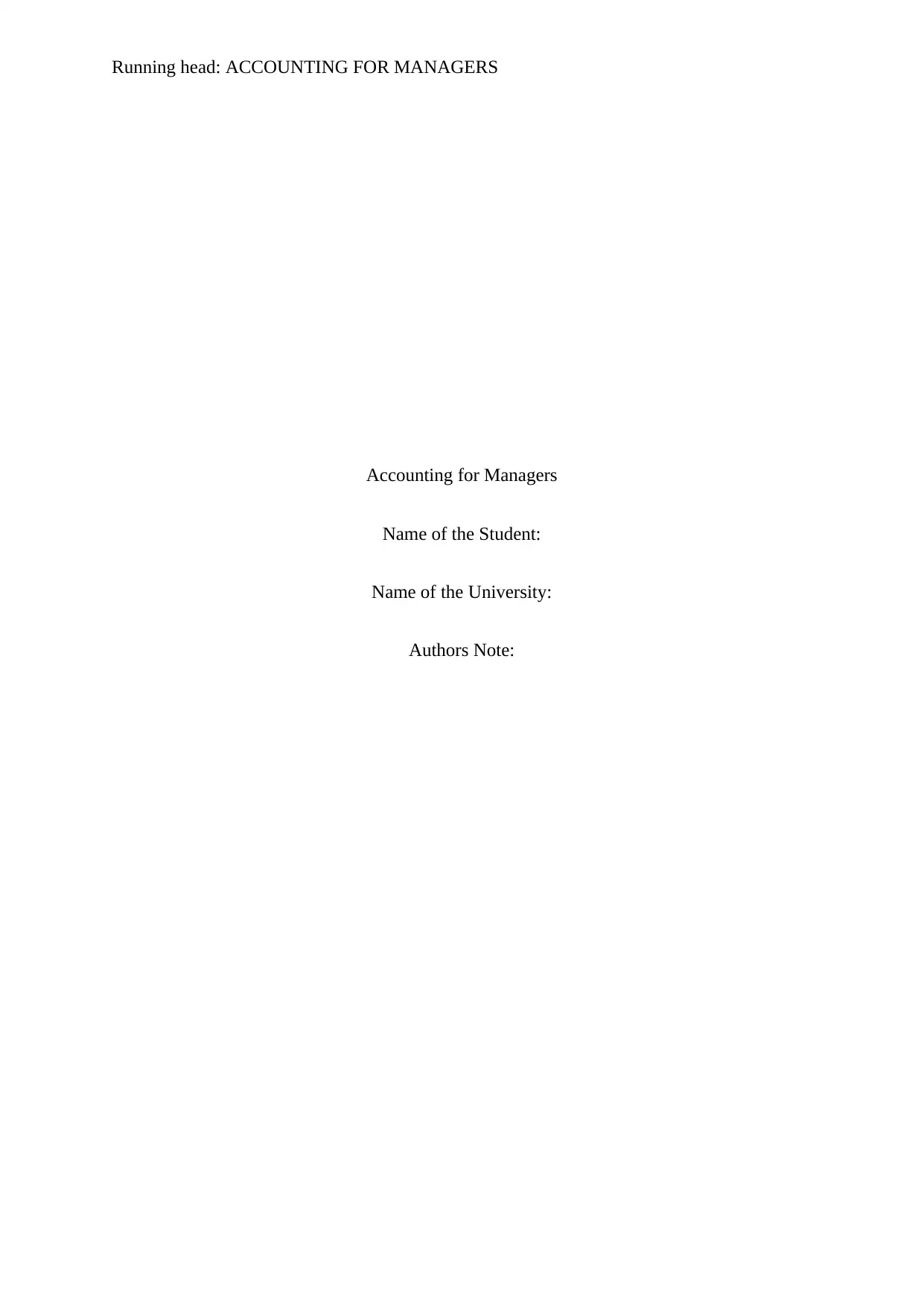
Running head: ACCOUNTING FOR MANAGERS
Accounting for Managers
Name of the Student:
Name of the University:
Authors Note:
Accounting for Managers
Name of the Student:
Name of the University:
Authors Note:
Paraphrase This Document
Need a fresh take? Get an instant paraphrase of this document with our AI Paraphraser
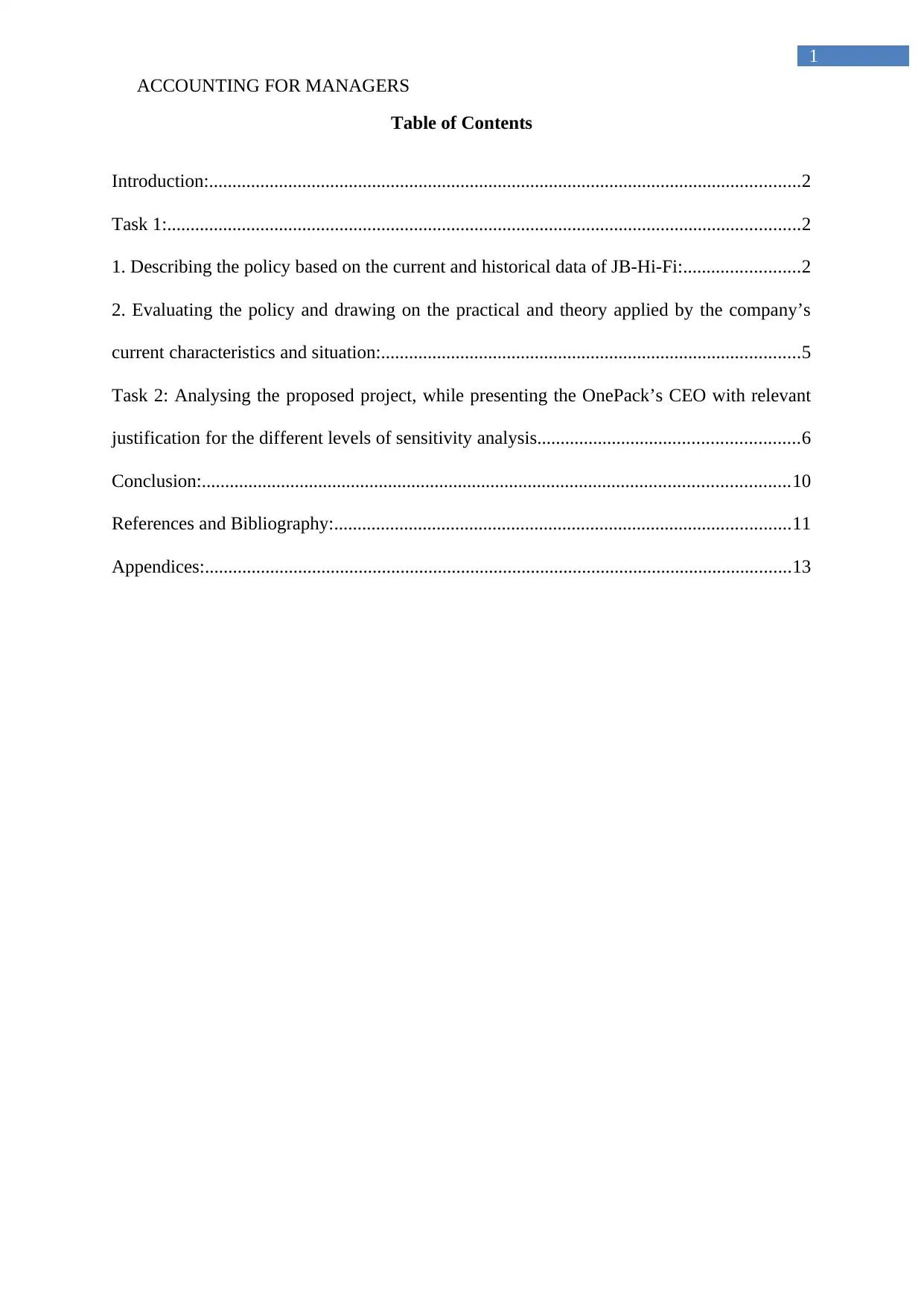
ACCOUNTING FOR MANAGERS
1
Table of Contents
Introduction:...............................................................................................................................2
Task 1:........................................................................................................................................2
1. Describing the policy based on the current and historical data of JB-Hi-Fi:.........................2
2. Evaluating the policy and drawing on the practical and theory applied by the company’s
current characteristics and situation:..........................................................................................5
Task 2: Analysing the proposed project, while presenting the OnePack’s CEO with relevant
justification for the different levels of sensitivity analysis........................................................6
Conclusion:..............................................................................................................................10
References and Bibliography:..................................................................................................11
Appendices:..............................................................................................................................13
1
Table of Contents
Introduction:...............................................................................................................................2
Task 1:........................................................................................................................................2
1. Describing the policy based on the current and historical data of JB-Hi-Fi:.........................2
2. Evaluating the policy and drawing on the practical and theory applied by the company’s
current characteristics and situation:..........................................................................................5
Task 2: Analysing the proposed project, while presenting the OnePack’s CEO with relevant
justification for the different levels of sensitivity analysis........................................................6
Conclusion:..............................................................................................................................10
References and Bibliography:..................................................................................................11
Appendices:..............................................................................................................................13
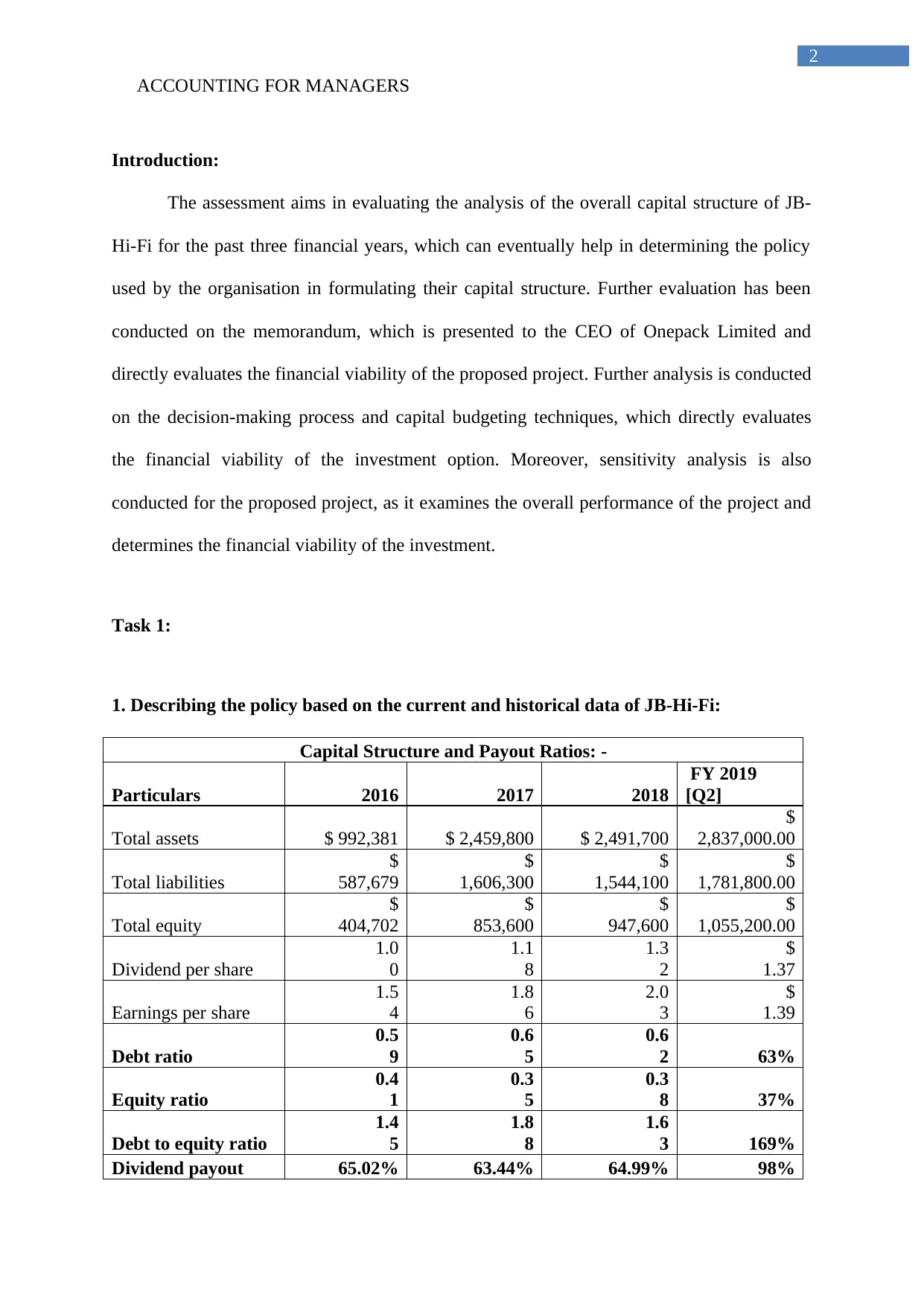
ACCOUNTING FOR MANAGERS
2
Introduction:
The assessment aims in evaluating the analysis of the overall capital structure of JB-
Hi-Fi for the past three financial years, which can eventually help in determining the policy
used by the organisation in formulating their capital structure. Further evaluation has been
conducted on the memorandum, which is presented to the CEO of Onepack Limited and
directly evaluates the financial viability of the proposed project. Further analysis is conducted
on the decision-making process and capital budgeting techniques, which directly evaluates
the financial viability of the investment option. Moreover, sensitivity analysis is also
conducted for the proposed project, as it examines the overall performance of the project and
determines the financial viability of the investment.
Task 1:
1. Describing the policy based on the current and historical data of JB-Hi-Fi:
Capital Structure and Payout Ratios: -
Particulars 2016 2017 2018
FY 2019
[Q2]
Total assets $ 992,381 $ 2,459,800 $ 2,491,700
$
2,837,000.00
Total liabilities
$
587,679
$
1,606,300
$
1,544,100
$
1,781,800.00
Total equity
$
404,702
$
853,600
$
947,600
$
1,055,200.00
Dividend per share
1.0
0
1.1
8
1.3
2
$
1.37
Earnings per share
1.5
4
1.8
6
2.0
3
$
1.39
Debt ratio
0.5
9
0.6
5
0.6
2 63%
Equity ratio
0.4
1
0.3
5
0.3
8 37%
Debt to equity ratio
1.4
5
1.8
8
1.6
3 169%
Dividend payout 65.02% 63.44% 64.99% 98%
2
Introduction:
The assessment aims in evaluating the analysis of the overall capital structure of JB-
Hi-Fi for the past three financial years, which can eventually help in determining the policy
used by the organisation in formulating their capital structure. Further evaluation has been
conducted on the memorandum, which is presented to the CEO of Onepack Limited and
directly evaluates the financial viability of the proposed project. Further analysis is conducted
on the decision-making process and capital budgeting techniques, which directly evaluates
the financial viability of the investment option. Moreover, sensitivity analysis is also
conducted for the proposed project, as it examines the overall performance of the project and
determines the financial viability of the investment.
Task 1:
1. Describing the policy based on the current and historical data of JB-Hi-Fi:
Capital Structure and Payout Ratios: -
Particulars 2016 2017 2018
FY 2019
[Q2]
Total assets $ 992,381 $ 2,459,800 $ 2,491,700
$
2,837,000.00
Total liabilities
$
587,679
$
1,606,300
$
1,544,100
$
1,781,800.00
Total equity
$
404,702
$
853,600
$
947,600
$
1,055,200.00
Dividend per share
1.0
0
1.1
8
1.3
2
$
1.37
Earnings per share
1.5
4
1.8
6
2.0
3
$
1.39
Debt ratio
0.5
9
0.6
5
0.6
2 63%
Equity ratio
0.4
1
0.3
5
0.3
8 37%
Debt to equity ratio
1.4
5
1.8
8
1.6
3 169%
Dividend payout 65.02% 63.44% 64.99% 98%
⊘ This is a preview!⊘
Do you want full access?
Subscribe today to unlock all pages.

Trusted by 1+ million students worldwide
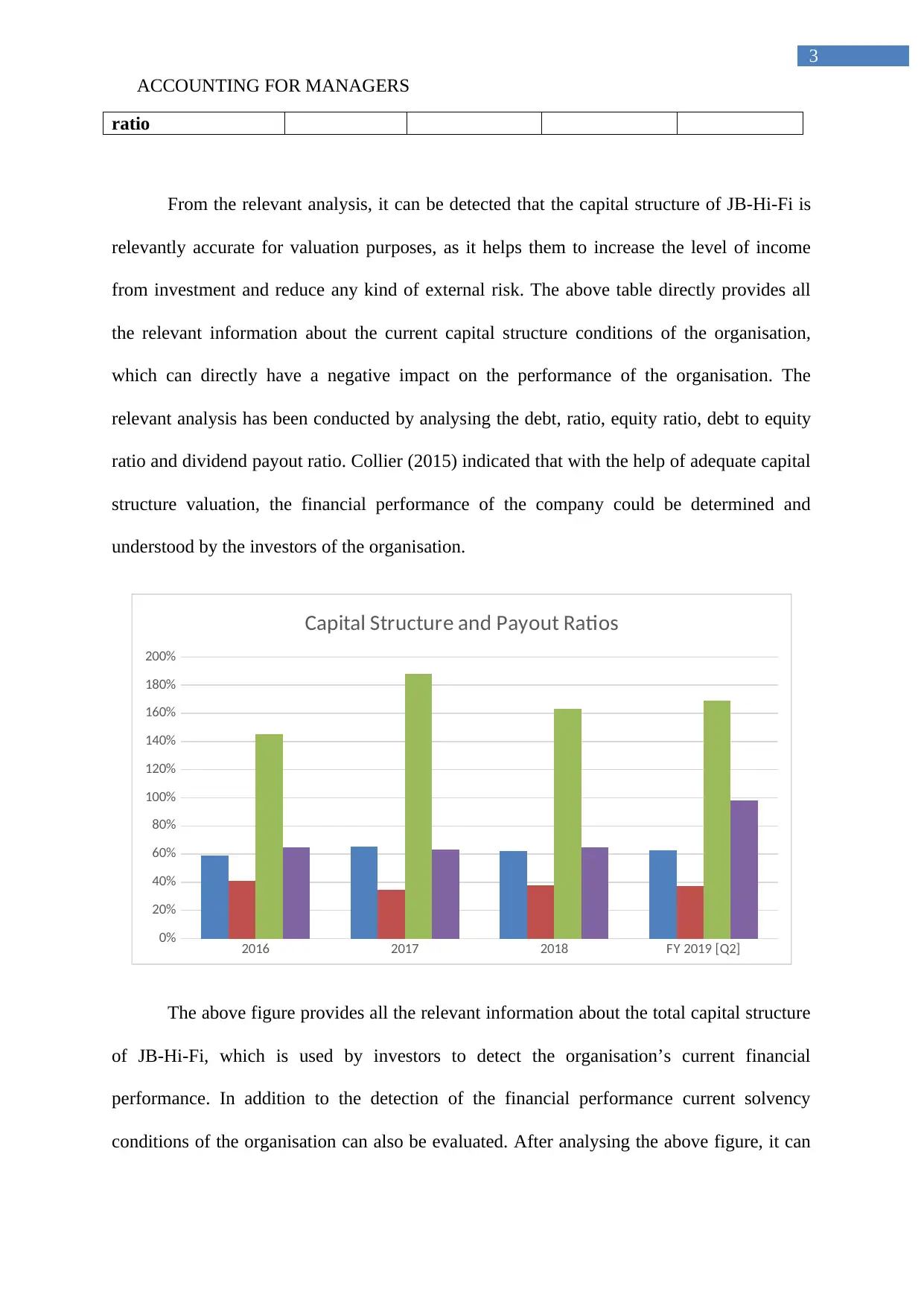
ACCOUNTING FOR MANAGERS
3
ratio
From the relevant analysis, it can be detected that the capital structure of JB-Hi-Fi is
relevantly accurate for valuation purposes, as it helps them to increase the level of income
from investment and reduce any kind of external risk. The above table directly provides all
the relevant information about the current capital structure conditions of the organisation,
which can directly have a negative impact on the performance of the organisation. The
relevant analysis has been conducted by analysing the debt, ratio, equity ratio, debt to equity
ratio and dividend payout ratio. Collier (2015) indicated that with the help of adequate capital
structure valuation, the financial performance of the company could be determined and
understood by the investors of the organisation.
2016 2017 2018 FY 2019 [Q2]
0%
20%
40%
60%
80%
100%
120%
140%
160%
180%
200%
Capital Structure and Payout Ratios
The above figure provides all the relevant information about the total capital structure
of JB-Hi-Fi, which is used by investors to detect the organisation’s current financial
performance. In addition to the detection of the financial performance current solvency
conditions of the organisation can also be evaluated. After analysing the above figure, it can
3
ratio
From the relevant analysis, it can be detected that the capital structure of JB-Hi-Fi is
relevantly accurate for valuation purposes, as it helps them to increase the level of income
from investment and reduce any kind of external risk. The above table directly provides all
the relevant information about the current capital structure conditions of the organisation,
which can directly have a negative impact on the performance of the organisation. The
relevant analysis has been conducted by analysing the debt, ratio, equity ratio, debt to equity
ratio and dividend payout ratio. Collier (2015) indicated that with the help of adequate capital
structure valuation, the financial performance of the company could be determined and
understood by the investors of the organisation.
2016 2017 2018 FY 2019 [Q2]
0%
20%
40%
60%
80%
100%
120%
140%
160%
180%
200%
Capital Structure and Payout Ratios
The above figure provides all the relevant information about the total capital structure
of JB-Hi-Fi, which is used by investors to detect the organisation’s current financial
performance. In addition to the detection of the financial performance current solvency
conditions of the organisation can also be evaluated. After analysing the above figure, it can
Paraphrase This Document
Need a fresh take? Get an instant paraphrase of this document with our AI Paraphraser
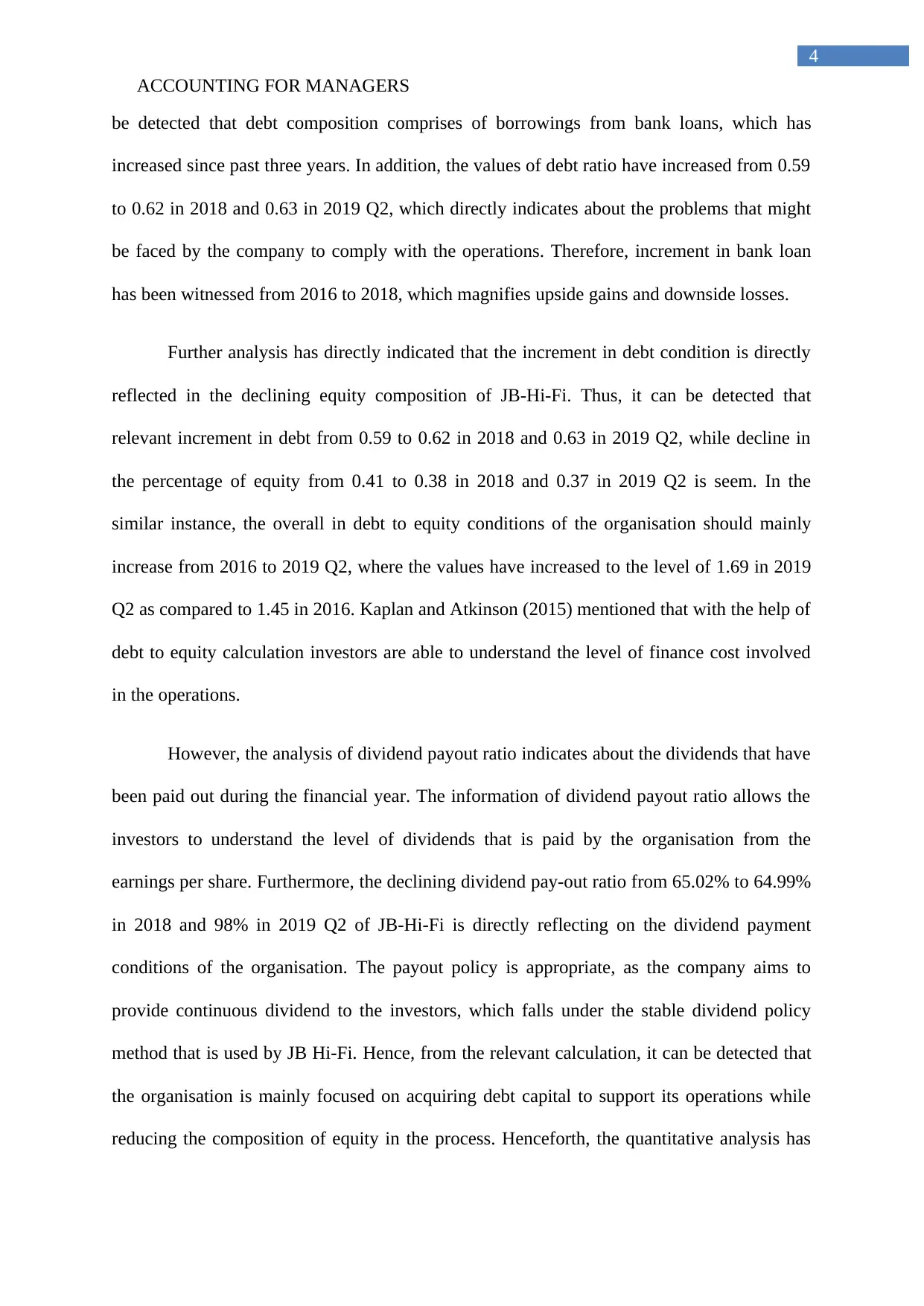
ACCOUNTING FOR MANAGERS
4
be detected that debt composition comprises of borrowings from bank loans, which has
increased since past three years. In addition, the values of debt ratio have increased from 0.59
to 0.62 in 2018 and 0.63 in 2019 Q2, which directly indicates about the problems that might
be faced by the company to comply with the operations. Therefore, increment in bank loan
has been witnessed from 2016 to 2018, which magnifies upside gains and downside losses.
Further analysis has directly indicated that the increment in debt condition is directly
reflected in the declining equity composition of JB-Hi-Fi. Thus, it can be detected that
relevant increment in debt from 0.59 to 0.62 in 2018 and 0.63 in 2019 Q2, while decline in
the percentage of equity from 0.41 to 0.38 in 2018 and 0.37 in 2019 Q2 is seem. In the
similar instance, the overall in debt to equity conditions of the organisation should mainly
increase from 2016 to 2019 Q2, where the values have increased to the level of 1.69 in 2019
Q2 as compared to 1.45 in 2016. Kaplan and Atkinson (2015) mentioned that with the help of
debt to equity calculation investors are able to understand the level of finance cost involved
in the operations.
However, the analysis of dividend payout ratio indicates about the dividends that have
been paid out during the financial year. The information of dividend payout ratio allows the
investors to understand the level of dividends that is paid by the organisation from the
earnings per share. Furthermore, the declining dividend pay-out ratio from 65.02% to 64.99%
in 2018 and 98% in 2019 Q2 of JB-Hi-Fi is directly reflecting on the dividend payment
conditions of the organisation. The payout policy is appropriate, as the company aims to
provide continuous dividend to the investors, which falls under the stable dividend policy
method that is used by JB Hi-Fi. Hence, from the relevant calculation, it can be detected that
the organisation is mainly focused on acquiring debt capital to support its operations while
reducing the composition of equity in the process. Henceforth, the quantitative analysis has
4
be detected that debt composition comprises of borrowings from bank loans, which has
increased since past three years. In addition, the values of debt ratio have increased from 0.59
to 0.62 in 2018 and 0.63 in 2019 Q2, which directly indicates about the problems that might
be faced by the company to comply with the operations. Therefore, increment in bank loan
has been witnessed from 2016 to 2018, which magnifies upside gains and downside losses.
Further analysis has directly indicated that the increment in debt condition is directly
reflected in the declining equity composition of JB-Hi-Fi. Thus, it can be detected that
relevant increment in debt from 0.59 to 0.62 in 2018 and 0.63 in 2019 Q2, while decline in
the percentage of equity from 0.41 to 0.38 in 2018 and 0.37 in 2019 Q2 is seem. In the
similar instance, the overall in debt to equity conditions of the organisation should mainly
increase from 2016 to 2019 Q2, where the values have increased to the level of 1.69 in 2019
Q2 as compared to 1.45 in 2016. Kaplan and Atkinson (2015) mentioned that with the help of
debt to equity calculation investors are able to understand the level of finance cost involved
in the operations.
However, the analysis of dividend payout ratio indicates about the dividends that have
been paid out during the financial year. The information of dividend payout ratio allows the
investors to understand the level of dividends that is paid by the organisation from the
earnings per share. Furthermore, the declining dividend pay-out ratio from 65.02% to 64.99%
in 2018 and 98% in 2019 Q2 of JB-Hi-Fi is directly reflecting on the dividend payment
conditions of the organisation. The payout policy is appropriate, as the company aims to
provide continuous dividend to the investors, which falls under the stable dividend policy
method that is used by JB Hi-Fi. Hence, from the relevant calculation, it can be detected that
the organisation is mainly focused on acquiring debt capital to support its operations while
reducing the composition of equity in the process. Henceforth, the quantitative analysis has
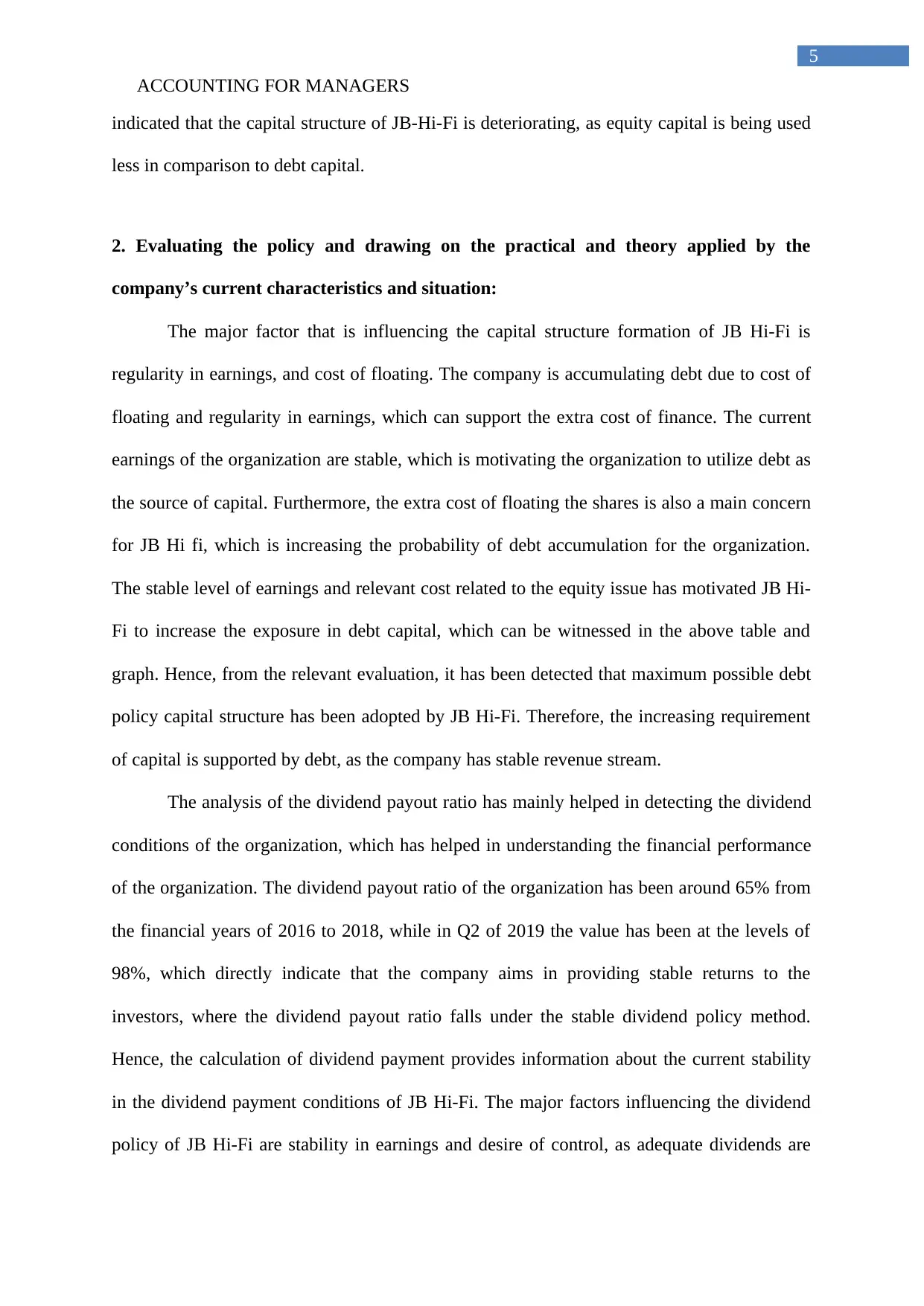
ACCOUNTING FOR MANAGERS
5
indicated that the capital structure of JB-Hi-Fi is deteriorating, as equity capital is being used
less in comparison to debt capital.
2. Evaluating the policy and drawing on the practical and theory applied by the
company’s current characteristics and situation:
The major factor that is influencing the capital structure formation of JB Hi-Fi is
regularity in earnings, and cost of floating. The company is accumulating debt due to cost of
floating and regularity in earnings, which can support the extra cost of finance. The current
earnings of the organization are stable, which is motivating the organization to utilize debt as
the source of capital. Furthermore, the extra cost of floating the shares is also a main concern
for JB Hi fi, which is increasing the probability of debt accumulation for the organization.
The stable level of earnings and relevant cost related to the equity issue has motivated JB Hi-
Fi to increase the exposure in debt capital, which can be witnessed in the above table and
graph. Hence, from the relevant evaluation, it has been detected that maximum possible debt
policy capital structure has been adopted by JB Hi-Fi. Therefore, the increasing requirement
of capital is supported by debt, as the company has stable revenue stream.
The analysis of the dividend payout ratio has mainly helped in detecting the dividend
conditions of the organization, which has helped in understanding the financial performance
of the organization. The dividend payout ratio of the organization has been around 65% from
the financial years of 2016 to 2018, while in Q2 of 2019 the value has been at the levels of
98%, which directly indicate that the company aims in providing stable returns to the
investors, where the dividend payout ratio falls under the stable dividend policy method.
Hence, the calculation of dividend payment provides information about the current stability
in the dividend payment conditions of JB Hi-Fi. The major factors influencing the dividend
policy of JB Hi-Fi are stability in earnings and desire of control, as adequate dividends are
5
indicated that the capital structure of JB-Hi-Fi is deteriorating, as equity capital is being used
less in comparison to debt capital.
2. Evaluating the policy and drawing on the practical and theory applied by the
company’s current characteristics and situation:
The major factor that is influencing the capital structure formation of JB Hi-Fi is
regularity in earnings, and cost of floating. The company is accumulating debt due to cost of
floating and regularity in earnings, which can support the extra cost of finance. The current
earnings of the organization are stable, which is motivating the organization to utilize debt as
the source of capital. Furthermore, the extra cost of floating the shares is also a main concern
for JB Hi fi, which is increasing the probability of debt accumulation for the organization.
The stable level of earnings and relevant cost related to the equity issue has motivated JB Hi-
Fi to increase the exposure in debt capital, which can be witnessed in the above table and
graph. Hence, from the relevant evaluation, it has been detected that maximum possible debt
policy capital structure has been adopted by JB Hi-Fi. Therefore, the increasing requirement
of capital is supported by debt, as the company has stable revenue stream.
The analysis of the dividend payout ratio has mainly helped in detecting the dividend
conditions of the organization, which has helped in understanding the financial performance
of the organization. The dividend payout ratio of the organization has been around 65% from
the financial years of 2016 to 2018, while in Q2 of 2019 the value has been at the levels of
98%, which directly indicate that the company aims in providing stable returns to the
investors, where the dividend payout ratio falls under the stable dividend policy method.
Hence, the calculation of dividend payment provides information about the current stability
in the dividend payment conditions of JB Hi-Fi. The major factors influencing the dividend
policy of JB Hi-Fi are stability in earnings and desire of control, as adequate dividends are
⊘ This is a preview!⊘
Do you want full access?
Subscribe today to unlock all pages.

Trusted by 1+ million students worldwide
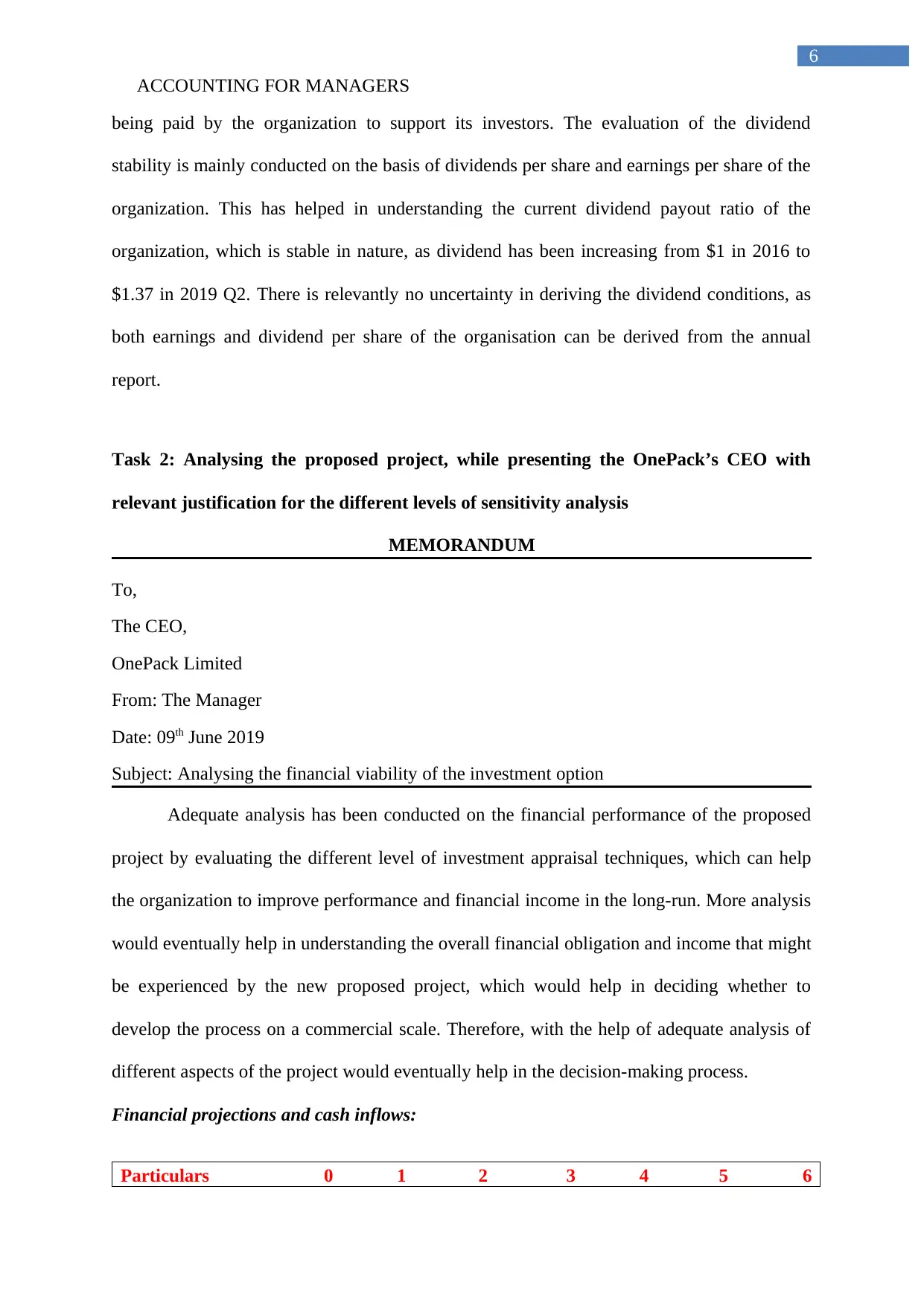
ACCOUNTING FOR MANAGERS
6
being paid by the organization to support its investors. The evaluation of the dividend
stability is mainly conducted on the basis of dividends per share and earnings per share of the
organization. This has helped in understanding the current dividend payout ratio of the
organization, which is stable in nature, as dividend has been increasing from $1 in 2016 to
$1.37 in 2019 Q2. There is relevantly no uncertainty in deriving the dividend conditions, as
both earnings and dividend per share of the organisation can be derived from the annual
report.
Task 2: Analysing the proposed project, while presenting the OnePack’s CEO with
relevant justification for the different levels of sensitivity analysis
MEMORANDUM
To,
The CEO,
OnePack Limited
From: The Manager
Date: 09th June 2019
Subject: Analysing the financial viability of the investment option
Adequate analysis has been conducted on the financial performance of the proposed
project by evaluating the different level of investment appraisal techniques, which can help
the organization to improve performance and financial income in the long-run. More analysis
would eventually help in understanding the overall financial obligation and income that might
be experienced by the new proposed project, which would help in deciding whether to
develop the process on a commercial scale. Therefore, with the help of adequate analysis of
different aspects of the project would eventually help in the decision-making process.
Financial projections and cash inflows:
Particulars 0 1 2 3 4 5 6
6
being paid by the organization to support its investors. The evaluation of the dividend
stability is mainly conducted on the basis of dividends per share and earnings per share of the
organization. This has helped in understanding the current dividend payout ratio of the
organization, which is stable in nature, as dividend has been increasing from $1 in 2016 to
$1.37 in 2019 Q2. There is relevantly no uncertainty in deriving the dividend conditions, as
both earnings and dividend per share of the organisation can be derived from the annual
report.
Task 2: Analysing the proposed project, while presenting the OnePack’s CEO with
relevant justification for the different levels of sensitivity analysis
MEMORANDUM
To,
The CEO,
OnePack Limited
From: The Manager
Date: 09th June 2019
Subject: Analysing the financial viability of the investment option
Adequate analysis has been conducted on the financial performance of the proposed
project by evaluating the different level of investment appraisal techniques, which can help
the organization to improve performance and financial income in the long-run. More analysis
would eventually help in understanding the overall financial obligation and income that might
be experienced by the new proposed project, which would help in deciding whether to
develop the process on a commercial scale. Therefore, with the help of adequate analysis of
different aspects of the project would eventually help in the decision-making process.
Financial projections and cash inflows:
Particulars 0 1 2 3 4 5 6
Paraphrase This Document
Need a fresh take? Get an instant paraphrase of this document with our AI Paraphraser
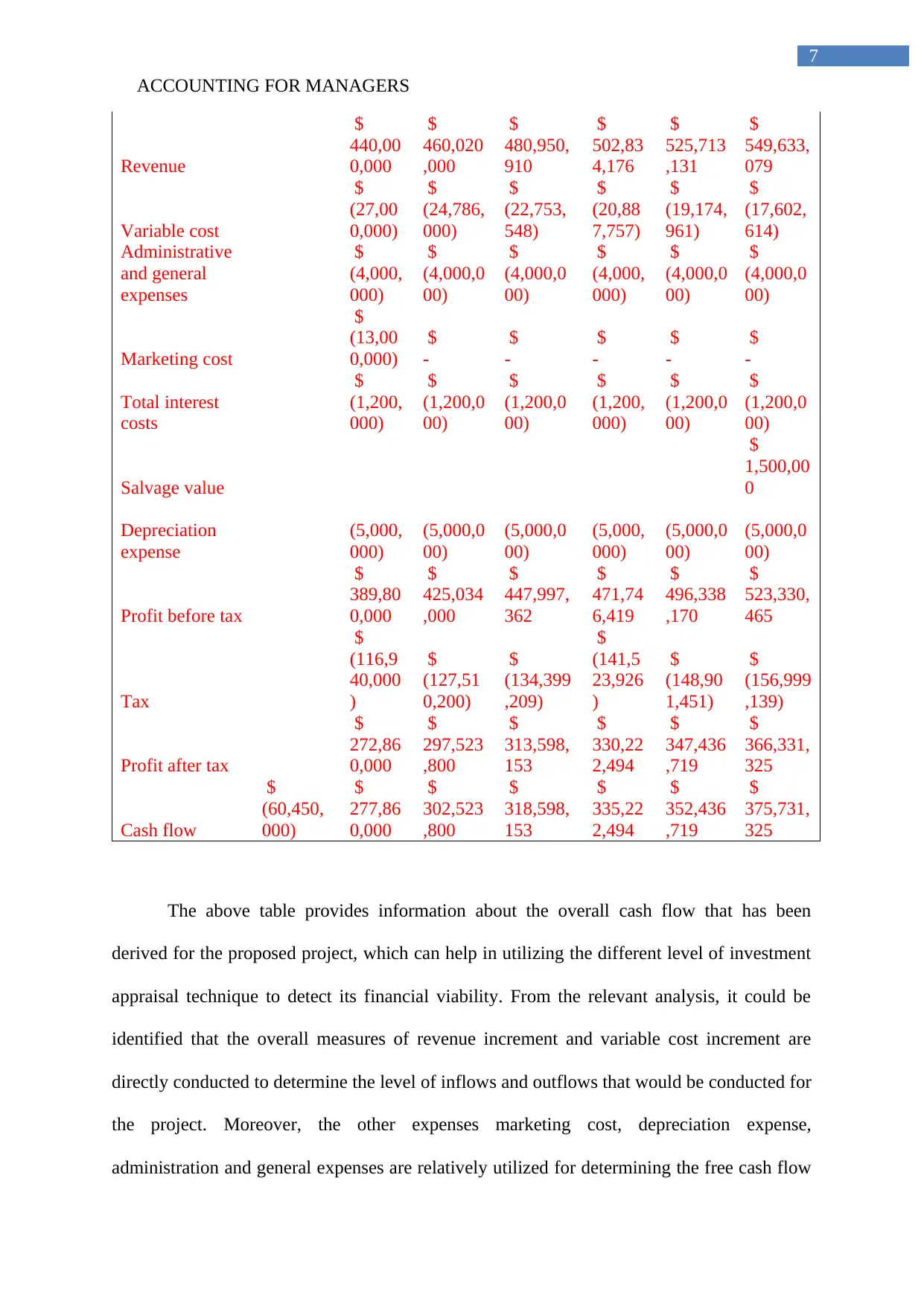
ACCOUNTING FOR MANAGERS
7
Revenue
$
440,00
0,000
$
460,020
,000
$
480,950,
910
$
502,83
4,176
$
525,713
,131
$
549,633,
079
Variable cost
$
(27,00
0,000)
$
(24,786,
000)
$
(22,753,
548)
$
(20,88
7,757)
$
(19,174,
961)
$
(17,602,
614)
Administrative
and general
expenses
$
(4,000,
000)
$
(4,000,0
00)
$
(4,000,0
00)
$
(4,000,
000)
$
(4,000,0
00)
$
(4,000,0
00)
Marketing cost
$
(13,00
0,000)
$
-
$
-
$
-
$
-
$
-
Total interest
costs
$
(1,200,
000)
$
(1,200,0
00)
$
(1,200,0
00)
$
(1,200,
000)
$
(1,200,0
00)
$
(1,200,0
00)
Salvage value
$
1,500,00
0
Depreciation
expense
(5,000,
000)
(5,000,0
00)
(5,000,0
00)
(5,000,
000)
(5,000,0
00)
(5,000,0
00)
Profit before tax
$
389,80
0,000
$
425,034
,000
$
447,997,
362
$
471,74
6,419
$
496,338
,170
$
523,330,
465
Tax
$
(116,9
40,000
)
$
(127,51
0,200)
$
(134,399
,209)
$
(141,5
23,926
)
$
(148,90
1,451)
$
(156,999
,139)
Profit after tax
$
272,86
0,000
$
297,523
,800
$
313,598,
153
$
330,22
2,494
$
347,436
,719
$
366,331,
325
Cash flow
$
(60,450,
000)
$
277,86
0,000
$
302,523
,800
$
318,598,
153
$
335,22
2,494
$
352,436
,719
$
375,731,
325
The above table provides information about the overall cash flow that has been
derived for the proposed project, which can help in utilizing the different level of investment
appraisal technique to detect its financial viability. From the relevant analysis, it could be
identified that the overall measures of revenue increment and variable cost increment are
directly conducted to determine the level of inflows and outflows that would be conducted for
the project. Moreover, the other expenses marketing cost, depreciation expense,
administration and general expenses are relatively utilized for determining the free cash flow
7
Revenue
$
440,00
0,000
$
460,020
,000
$
480,950,
910
$
502,83
4,176
$
525,713
,131
$
549,633,
079
Variable cost
$
(27,00
0,000)
$
(24,786,
000)
$
(22,753,
548)
$
(20,88
7,757)
$
(19,174,
961)
$
(17,602,
614)
Administrative
and general
expenses
$
(4,000,
000)
$
(4,000,0
00)
$
(4,000,0
00)
$
(4,000,
000)
$
(4,000,0
00)
$
(4,000,0
00)
Marketing cost
$
(13,00
0,000)
$
-
$
-
$
-
$
-
$
-
Total interest
costs
$
(1,200,
000)
$
(1,200,0
00)
$
(1,200,0
00)
$
(1,200,
000)
$
(1,200,0
00)
$
(1,200,0
00)
Salvage value
$
1,500,00
0
Depreciation
expense
(5,000,
000)
(5,000,0
00)
(5,000,0
00)
(5,000,
000)
(5,000,0
00)
(5,000,0
00)
Profit before tax
$
389,80
0,000
$
425,034
,000
$
447,997,
362
$
471,74
6,419
$
496,338
,170
$
523,330,
465
Tax
$
(116,9
40,000
)
$
(127,51
0,200)
$
(134,399
,209)
$
(141,5
23,926
)
$
(148,90
1,451)
$
(156,999
,139)
Profit after tax
$
272,86
0,000
$
297,523
,800
$
313,598,
153
$
330,22
2,494
$
347,436
,719
$
366,331,
325
Cash flow
$
(60,450,
000)
$
277,86
0,000
$
302,523
,800
$
318,598,
153
$
335,22
2,494
$
352,436
,719
$
375,731,
325
The above table provides information about the overall cash flow that has been
derived for the proposed project, which can help in utilizing the different level of investment
appraisal technique to detect its financial viability. From the relevant analysis, it could be
identified that the overall measures of revenue increment and variable cost increment are
directly conducted to determine the level of inflows and outflows that would be conducted for
the project. Moreover, the other expenses marketing cost, depreciation expense,
administration and general expenses are relatively utilized for determining the free cash flow
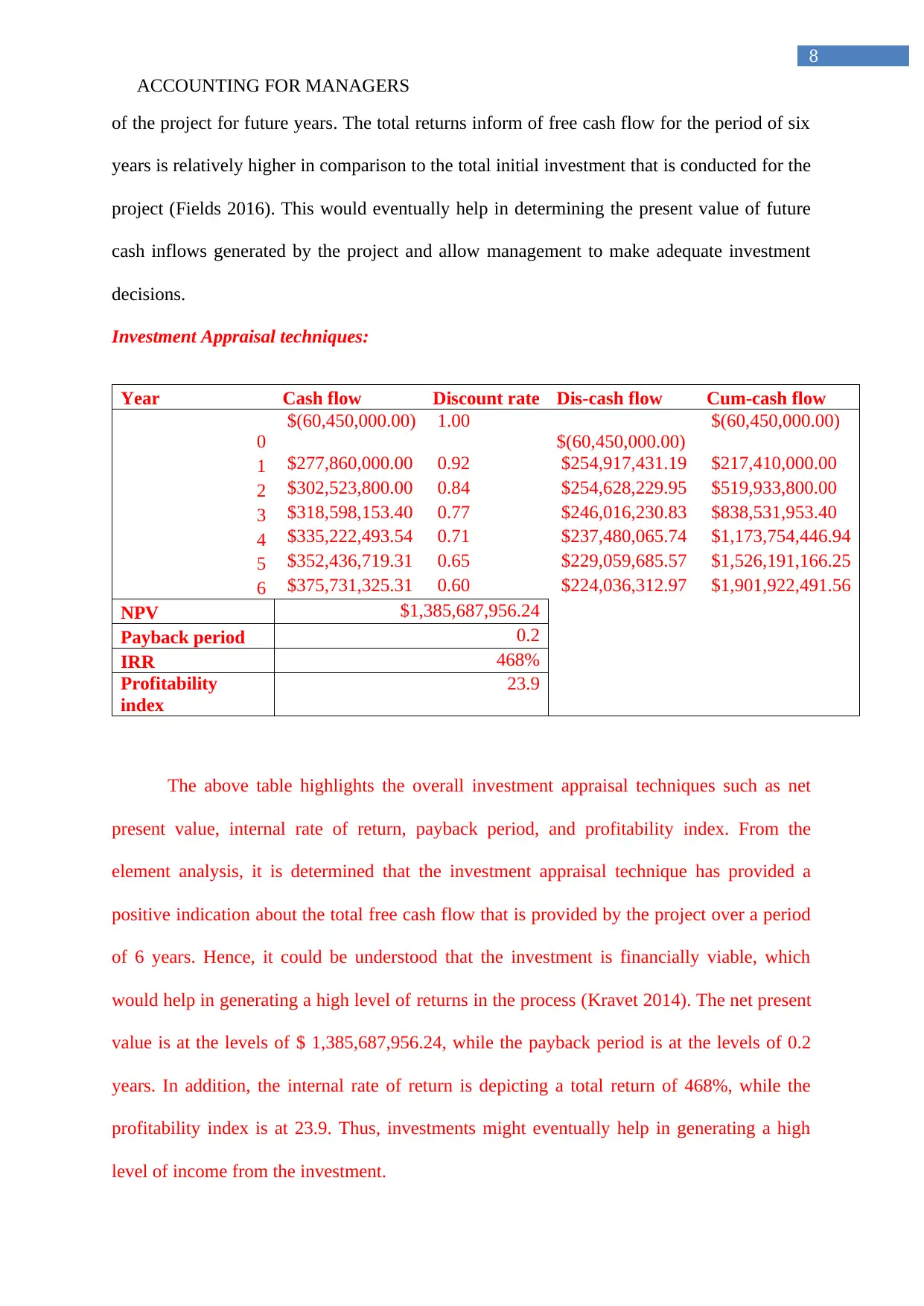
ACCOUNTING FOR MANAGERS
8
of the project for future years. The total returns inform of free cash flow for the period of six
years is relatively higher in comparison to the total initial investment that is conducted for the
project (Fields 2016). This would eventually help in determining the present value of future
cash inflows generated by the project and allow management to make adequate investment
decisions.
Investment Appraisal techniques:
Year Cash flow Discount rate Dis-cash flow Cum-cash flow
0
$(60,450,000.00) 1.00
$(60,450,000.00)
$(60,450,000.00)
1 $277,860,000.00 0.92 $254,917,431.19 $217,410,000.00
2 $302,523,800.00 0.84 $254,628,229.95 $519,933,800.00
3 $318,598,153.40 0.77 $246,016,230.83 $838,531,953.40
4 $335,222,493.54 0.71 $237,480,065.74 $1,173,754,446.94
5 $352,436,719.31 0.65 $229,059,685.57 $1,526,191,166.25
6 $375,731,325.31 0.60 $224,036,312.97 $1,901,922,491.56
NPV $1,385,687,956.24
Payback period 0.2
IRR 468%
Profitability
index
23.9
The above table highlights the overall investment appraisal techniques such as net
present value, internal rate of return, payback period, and profitability index. From the
element analysis, it is determined that the investment appraisal technique has provided a
positive indication about the total free cash flow that is provided by the project over a period
of 6 years. Hence, it could be understood that the investment is financially viable, which
would help in generating a high level of returns in the process (Kravet 2014). The net present
value is at the levels of $ 1,385,687,956.24, while the payback period is at the levels of 0.2
years. In addition, the internal rate of return is depicting a total return of 468%, while the
profitability index is at 23.9. Thus, investments might eventually help in generating a high
level of income from the investment.
8
of the project for future years. The total returns inform of free cash flow for the period of six
years is relatively higher in comparison to the total initial investment that is conducted for the
project (Fields 2016). This would eventually help in determining the present value of future
cash inflows generated by the project and allow management to make adequate investment
decisions.
Investment Appraisal techniques:
Year Cash flow Discount rate Dis-cash flow Cum-cash flow
0
$(60,450,000.00) 1.00
$(60,450,000.00)
$(60,450,000.00)
1 $277,860,000.00 0.92 $254,917,431.19 $217,410,000.00
2 $302,523,800.00 0.84 $254,628,229.95 $519,933,800.00
3 $318,598,153.40 0.77 $246,016,230.83 $838,531,953.40
4 $335,222,493.54 0.71 $237,480,065.74 $1,173,754,446.94
5 $352,436,719.31 0.65 $229,059,685.57 $1,526,191,166.25
6 $375,731,325.31 0.60 $224,036,312.97 $1,901,922,491.56
NPV $1,385,687,956.24
Payback period 0.2
IRR 468%
Profitability
index
23.9
The above table highlights the overall investment appraisal techniques such as net
present value, internal rate of return, payback period, and profitability index. From the
element analysis, it is determined that the investment appraisal technique has provided a
positive indication about the total free cash flow that is provided by the project over a period
of 6 years. Hence, it could be understood that the investment is financially viable, which
would help in generating a high level of returns in the process (Kravet 2014). The net present
value is at the levels of $ 1,385,687,956.24, while the payback period is at the levels of 0.2
years. In addition, the internal rate of return is depicting a total return of 468%, while the
profitability index is at 23.9. Thus, investments might eventually help in generating a high
level of income from the investment.
⊘ This is a preview!⊘
Do you want full access?
Subscribe today to unlock all pages.

Trusted by 1+ million students worldwide
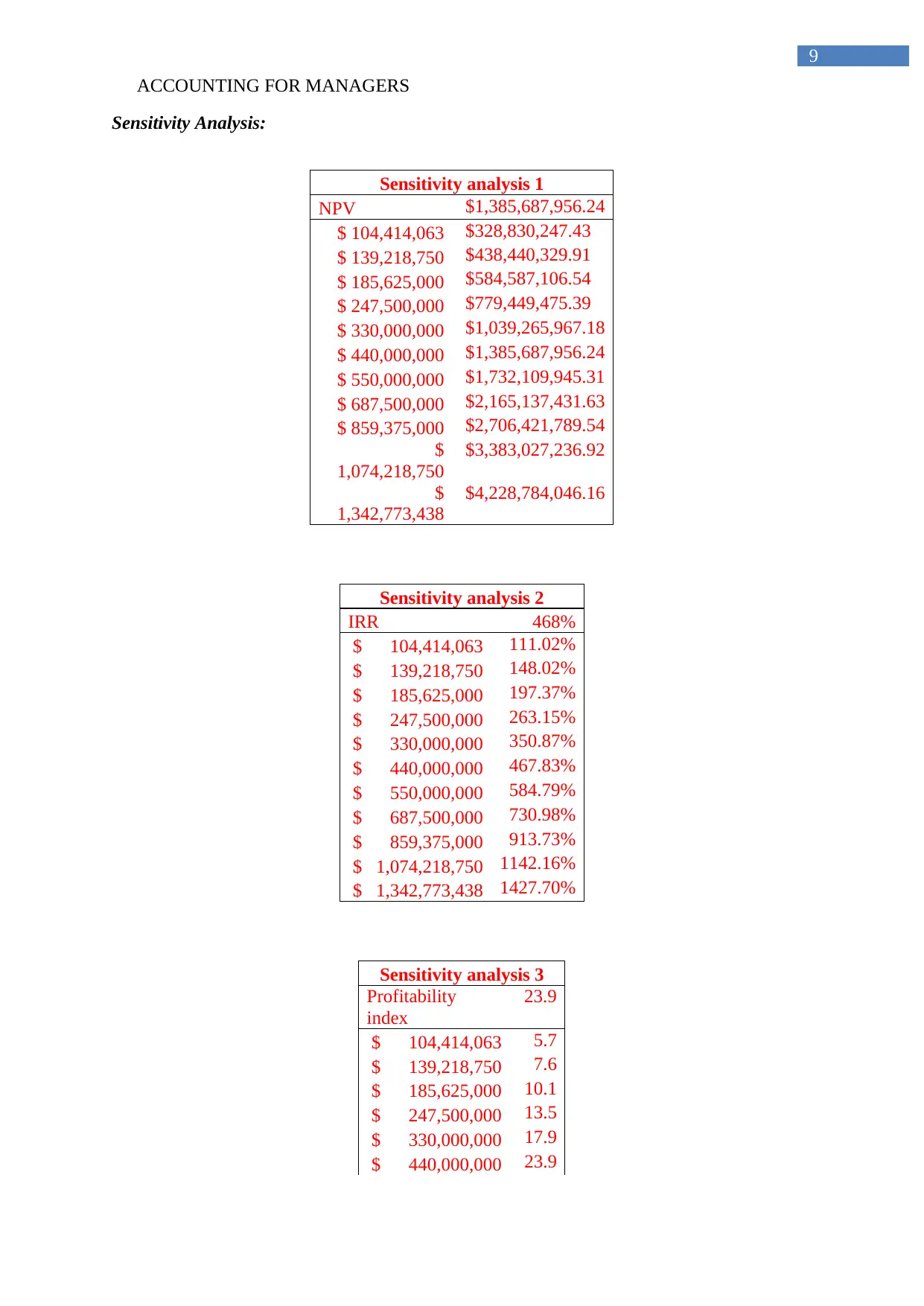
ACCOUNTING FOR MANAGERS
9
Sensitivity Analysis:
Sensitivity analysis 1
NPV $1,385,687,956.24
$ 104,414,063 $328,830,247.43
$ 139,218,750 $438,440,329.91
$ 185,625,000 $584,587,106.54
$ 247,500,000 $779,449,475.39
$ 330,000,000 $1,039,265,967.18
$ 440,000,000 $1,385,687,956.24
$ 550,000,000 $1,732,109,945.31
$ 687,500,000 $2,165,137,431.63
$ 859,375,000 $2,706,421,789.54
$
1,074,218,750
$3,383,027,236.92
$
1,342,773,438
$4,228,784,046.16
Sensitivity analysis 2
IRR 468%
$ 104,414,063 111.02%
$ 139,218,750 148.02%
$ 185,625,000 197.37%
$ 247,500,000 263.15%
$ 330,000,000 350.87%
$ 440,000,000 467.83%
$ 550,000,000 584.79%
$ 687,500,000 730.98%
$ 859,375,000 913.73%
$ 1,074,218,750 1142.16%
$ 1,342,773,438 1427.70%
Sensitivity analysis 3
Profitability
index
23.9
$ 104,414,063 5.7
$ 139,218,750 7.6
$ 185,625,000 10.1
$ 247,500,000 13.5
$ 330,000,000 17.9
$ 440,000,000 23.9
9
Sensitivity Analysis:
Sensitivity analysis 1
NPV $1,385,687,956.24
$ 104,414,063 $328,830,247.43
$ 139,218,750 $438,440,329.91
$ 185,625,000 $584,587,106.54
$ 247,500,000 $779,449,475.39
$ 330,000,000 $1,039,265,967.18
$ 440,000,000 $1,385,687,956.24
$ 550,000,000 $1,732,109,945.31
$ 687,500,000 $2,165,137,431.63
$ 859,375,000 $2,706,421,789.54
$
1,074,218,750
$3,383,027,236.92
$
1,342,773,438
$4,228,784,046.16
Sensitivity analysis 2
IRR 468%
$ 104,414,063 111.02%
$ 139,218,750 148.02%
$ 185,625,000 197.37%
$ 247,500,000 263.15%
$ 330,000,000 350.87%
$ 440,000,000 467.83%
$ 550,000,000 584.79%
$ 687,500,000 730.98%
$ 859,375,000 913.73%
$ 1,074,218,750 1142.16%
$ 1,342,773,438 1427.70%
Sensitivity analysis 3
Profitability
index
23.9
$ 104,414,063 5.7
$ 139,218,750 7.6
$ 185,625,000 10.1
$ 247,500,000 13.5
$ 330,000,000 17.9
$ 440,000,000 23.9
Paraphrase This Document
Need a fresh take? Get an instant paraphrase of this document with our AI Paraphraser
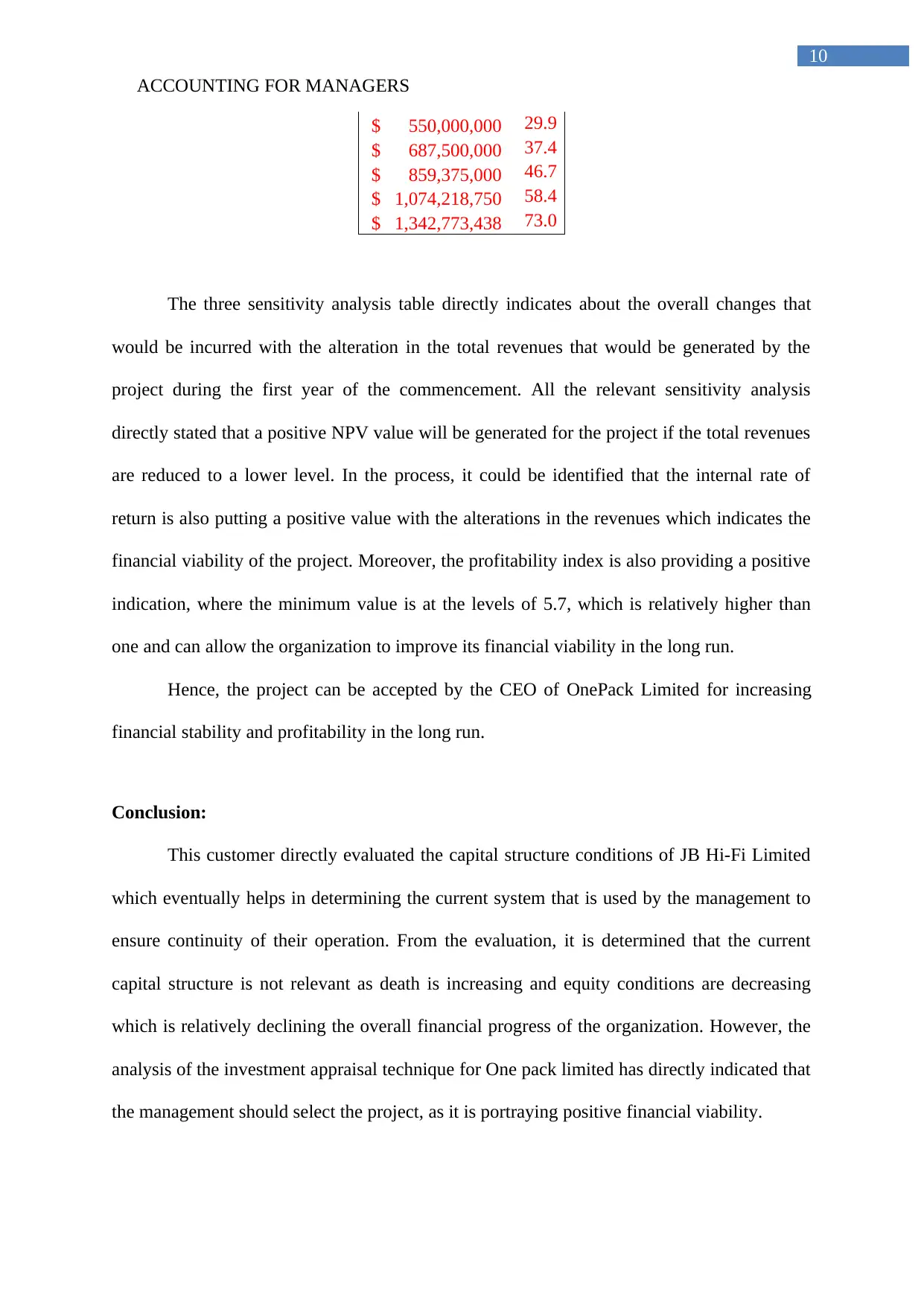
ACCOUNTING FOR MANAGERS
10
$ 550,000,000 29.9
$ 687,500,000 37.4
$ 859,375,000 46.7
$ 1,074,218,750 58.4
$ 1,342,773,438 73.0
The three sensitivity analysis table directly indicates about the overall changes that
would be incurred with the alteration in the total revenues that would be generated by the
project during the first year of the commencement. All the relevant sensitivity analysis
directly stated that a positive NPV value will be generated for the project if the total revenues
are reduced to a lower level. In the process, it could be identified that the internal rate of
return is also putting a positive value with the alterations in the revenues which indicates the
financial viability of the project. Moreover, the profitability index is also providing a positive
indication, where the minimum value is at the levels of 5.7, which is relatively higher than
one and can allow the organization to improve its financial viability in the long run.
Hence, the project can be accepted by the CEO of OnePack Limited for increasing
financial stability and profitability in the long run.
Conclusion:
This customer directly evaluated the capital structure conditions of JB Hi-Fi Limited
which eventually helps in determining the current system that is used by the management to
ensure continuity of their operation. From the evaluation, it is determined that the current
capital structure is not relevant as death is increasing and equity conditions are decreasing
which is relatively declining the overall financial progress of the organization. However, the
analysis of the investment appraisal technique for One pack limited has directly indicated that
the management should select the project, as it is portraying positive financial viability.
10
$ 550,000,000 29.9
$ 687,500,000 37.4
$ 859,375,000 46.7
$ 1,074,218,750 58.4
$ 1,342,773,438 73.0
The three sensitivity analysis table directly indicates about the overall changes that
would be incurred with the alteration in the total revenues that would be generated by the
project during the first year of the commencement. All the relevant sensitivity analysis
directly stated that a positive NPV value will be generated for the project if the total revenues
are reduced to a lower level. In the process, it could be identified that the internal rate of
return is also putting a positive value with the alterations in the revenues which indicates the
financial viability of the project. Moreover, the profitability index is also providing a positive
indication, where the minimum value is at the levels of 5.7, which is relatively higher than
one and can allow the organization to improve its financial viability in the long run.
Hence, the project can be accepted by the CEO of OnePack Limited for increasing
financial stability and profitability in the long run.
Conclusion:
This customer directly evaluated the capital structure conditions of JB Hi-Fi Limited
which eventually helps in determining the current system that is used by the management to
ensure continuity of their operation. From the evaluation, it is determined that the current
capital structure is not relevant as death is increasing and equity conditions are decreasing
which is relatively declining the overall financial progress of the organization. However, the
analysis of the investment appraisal technique for One pack limited has directly indicated that
the management should select the project, as it is portraying positive financial viability.
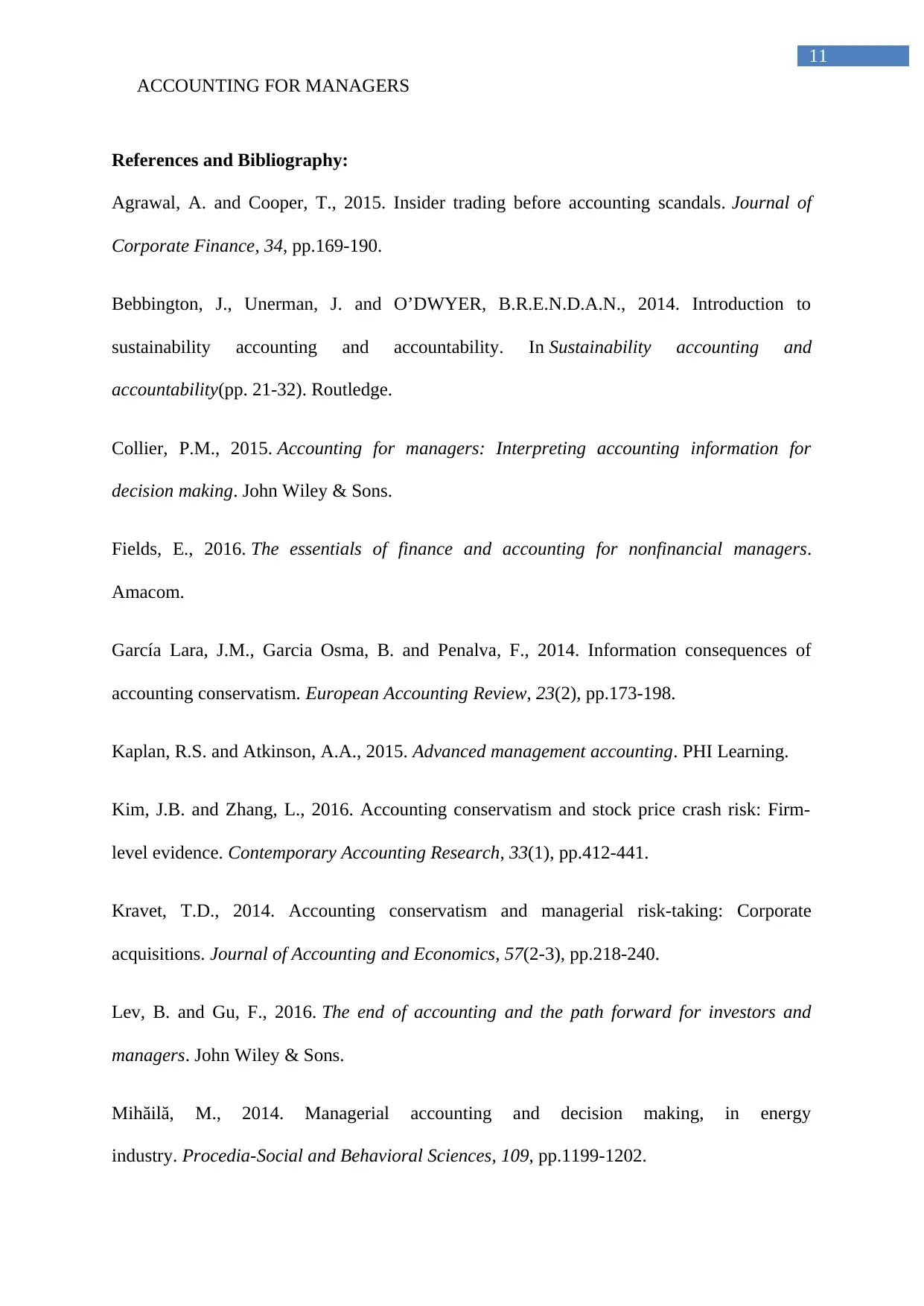
ACCOUNTING FOR MANAGERS
11
References and Bibliography:
Agrawal, A. and Cooper, T., 2015. Insider trading before accounting scandals. Journal of
Corporate Finance, 34, pp.169-190.
Bebbington, J., Unerman, J. and O’DWYER, B.R.E.N.D.A.N., 2014. Introduction to
sustainability accounting and accountability. In Sustainability accounting and
accountability(pp. 21-32). Routledge.
Collier, P.M., 2015. Accounting for managers: Interpreting accounting information for
decision making. John Wiley & Sons.
Fields, E., 2016. The essentials of finance and accounting for nonfinancial managers.
Amacom.
García Lara, J.M., Garcia Osma, B. and Penalva, F., 2014. Information consequences of
accounting conservatism. European Accounting Review, 23(2), pp.173-198.
Kaplan, R.S. and Atkinson, A.A., 2015. Advanced management accounting. PHI Learning.
Kim, J.B. and Zhang, L., 2016. Accounting conservatism and stock price crash risk: Firm‐
level evidence. Contemporary Accounting Research, 33(1), pp.412-441.
Kravet, T.D., 2014. Accounting conservatism and managerial risk-taking: Corporate
acquisitions. Journal of Accounting and Economics, 57(2-3), pp.218-240.
Lev, B. and Gu, F., 2016. The end of accounting and the path forward for investors and
managers. John Wiley & Sons.
Mihăilă, M., 2014. Managerial accounting and decision making, in energy
industry. Procedia-Social and Behavioral Sciences, 109, pp.1199-1202.
11
References and Bibliography:
Agrawal, A. and Cooper, T., 2015. Insider trading before accounting scandals. Journal of
Corporate Finance, 34, pp.169-190.
Bebbington, J., Unerman, J. and O’DWYER, B.R.E.N.D.A.N., 2014. Introduction to
sustainability accounting and accountability. In Sustainability accounting and
accountability(pp. 21-32). Routledge.
Collier, P.M., 2015. Accounting for managers: Interpreting accounting information for
decision making. John Wiley & Sons.
Fields, E., 2016. The essentials of finance and accounting for nonfinancial managers.
Amacom.
García Lara, J.M., Garcia Osma, B. and Penalva, F., 2014. Information consequences of
accounting conservatism. European Accounting Review, 23(2), pp.173-198.
Kaplan, R.S. and Atkinson, A.A., 2015. Advanced management accounting. PHI Learning.
Kim, J.B. and Zhang, L., 2016. Accounting conservatism and stock price crash risk: Firm‐
level evidence. Contemporary Accounting Research, 33(1), pp.412-441.
Kravet, T.D., 2014. Accounting conservatism and managerial risk-taking: Corporate
acquisitions. Journal of Accounting and Economics, 57(2-3), pp.218-240.
Lev, B. and Gu, F., 2016. The end of accounting and the path forward for investors and
managers. John Wiley & Sons.
Mihăilă, M., 2014. Managerial accounting and decision making, in energy
industry. Procedia-Social and Behavioral Sciences, 109, pp.1199-1202.
⊘ This is a preview!⊘
Do you want full access?
Subscribe today to unlock all pages.

Trusted by 1+ million students worldwide
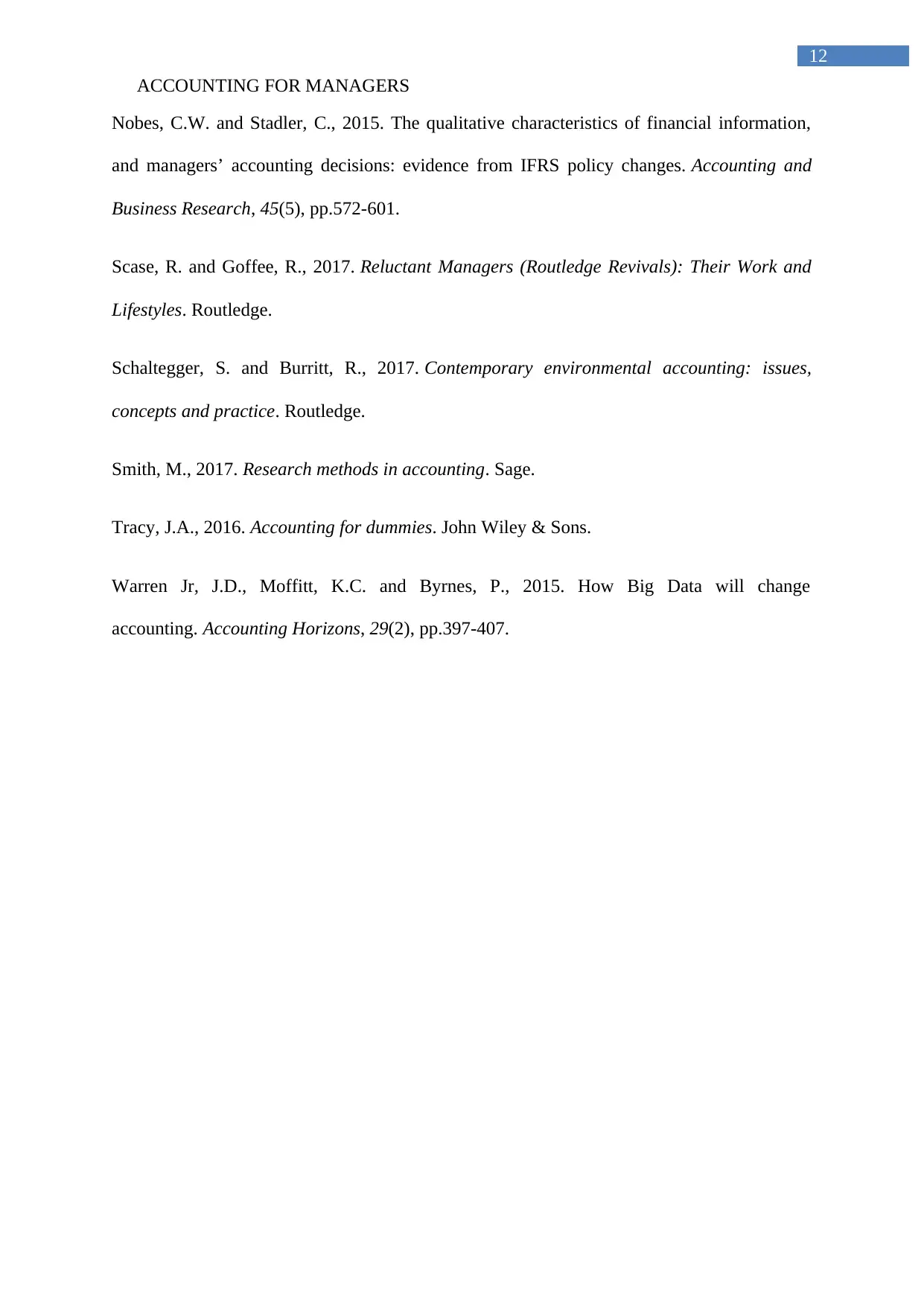
ACCOUNTING FOR MANAGERS
12
Nobes, C.W. and Stadler, C., 2015. The qualitative characteristics of financial information,
and managers’ accounting decisions: evidence from IFRS policy changes. Accounting and
Business Research, 45(5), pp.572-601.
Scase, R. and Goffee, R., 2017. Reluctant Managers (Routledge Revivals): Their Work and
Lifestyles. Routledge.
Schaltegger, S. and Burritt, R., 2017. Contemporary environmental accounting: issues,
concepts and practice. Routledge.
Smith, M., 2017. Research methods in accounting. Sage.
Tracy, J.A., 2016. Accounting for dummies. John Wiley & Sons.
Warren Jr, J.D., Moffitt, K.C. and Byrnes, P., 2015. How Big Data will change
accounting. Accounting Horizons, 29(2), pp.397-407.
12
Nobes, C.W. and Stadler, C., 2015. The qualitative characteristics of financial information,
and managers’ accounting decisions: evidence from IFRS policy changes. Accounting and
Business Research, 45(5), pp.572-601.
Scase, R. and Goffee, R., 2017. Reluctant Managers (Routledge Revivals): Their Work and
Lifestyles. Routledge.
Schaltegger, S. and Burritt, R., 2017. Contemporary environmental accounting: issues,
concepts and practice. Routledge.
Smith, M., 2017. Research methods in accounting. Sage.
Tracy, J.A., 2016. Accounting for dummies. John Wiley & Sons.
Warren Jr, J.D., Moffitt, K.C. and Byrnes, P., 2015. How Big Data will change
accounting. Accounting Horizons, 29(2), pp.397-407.
Paraphrase This Document
Need a fresh take? Get an instant paraphrase of this document with our AI Paraphraser
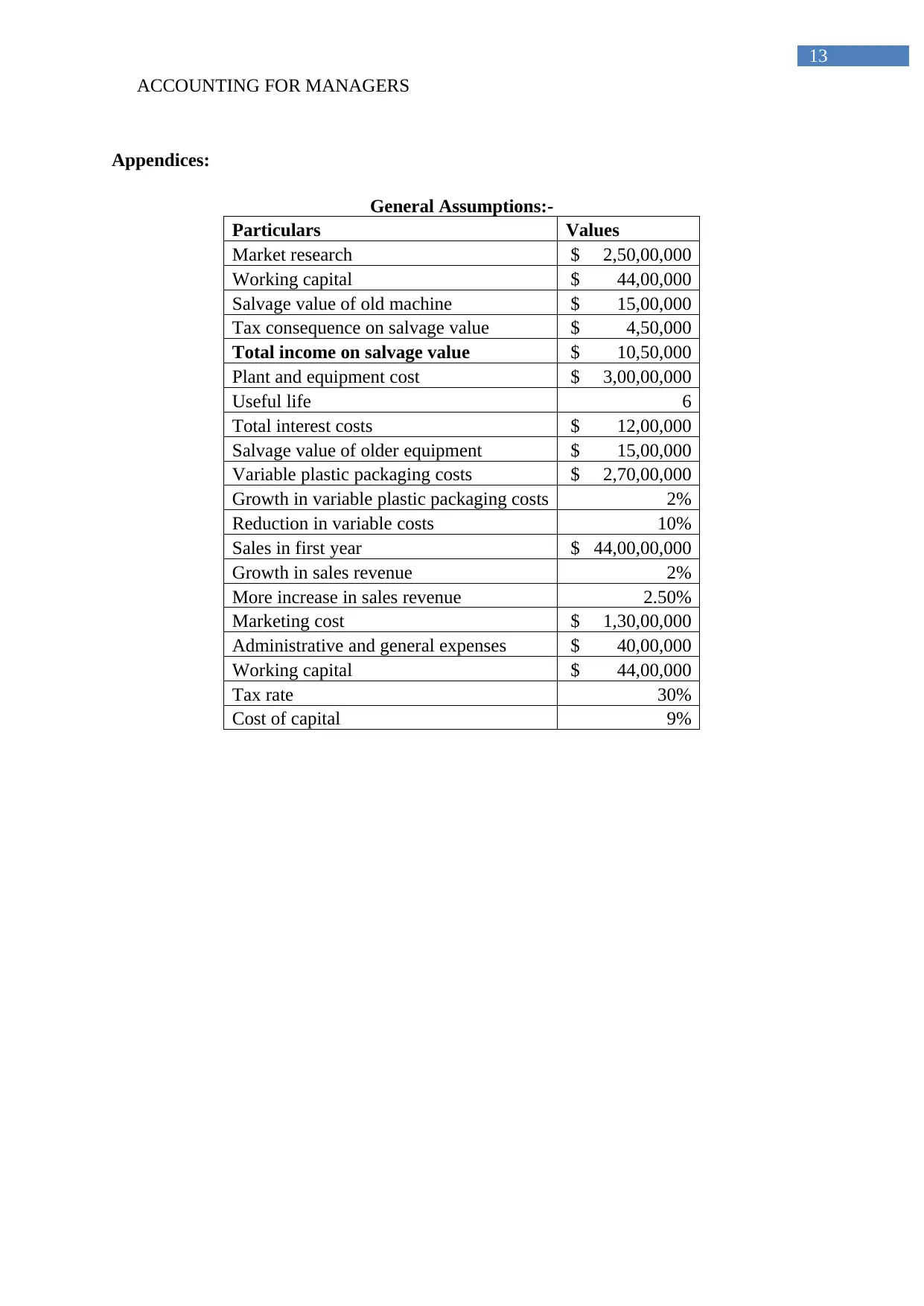
ACCOUNTING FOR MANAGERS
13
Appendices:
General Assumptions:-
Particulars Values
Market research $ 2,50,00,000
Working capital $ 44,00,000
Salvage value of old machine $ 15,00,000
Tax consequence on salvage value $ 4,50,000
Total income on salvage value $ 10,50,000
Plant and equipment cost $ 3,00,00,000
Useful life 6
Total interest costs $ 12,00,000
Salvage value of older equipment $ 15,00,000
Variable plastic packaging costs $ 2,70,00,000
Growth in variable plastic packaging costs 2%
Reduction in variable costs 10%
Sales in first year $ 44,00,00,000
Growth in sales revenue 2%
More increase in sales revenue 2.50%
Marketing cost $ 1,30,00,000
Administrative and general expenses $ 40,00,000
Working capital $ 44,00,000
Tax rate 30%
Cost of capital 9%
13
Appendices:
General Assumptions:-
Particulars Values
Market research $ 2,50,00,000
Working capital $ 44,00,000
Salvage value of old machine $ 15,00,000
Tax consequence on salvage value $ 4,50,000
Total income on salvage value $ 10,50,000
Plant and equipment cost $ 3,00,00,000
Useful life 6
Total interest costs $ 12,00,000
Salvage value of older equipment $ 15,00,000
Variable plastic packaging costs $ 2,70,00,000
Growth in variable plastic packaging costs 2%
Reduction in variable costs 10%
Sales in first year $ 44,00,00,000
Growth in sales revenue 2%
More increase in sales revenue 2.50%
Marketing cost $ 1,30,00,000
Administrative and general expenses $ 40,00,000
Working capital $ 44,00,000
Tax rate 30%
Cost of capital 9%
1 out of 14
Related Documents
Your All-in-One AI-Powered Toolkit for Academic Success.
+13062052269
info@desklib.com
Available 24*7 on WhatsApp / Email
![[object Object]](/_next/static/media/star-bottom.7253800d.svg)
Unlock your academic potential
© 2024 | Zucol Services PVT LTD | All rights reserved.





